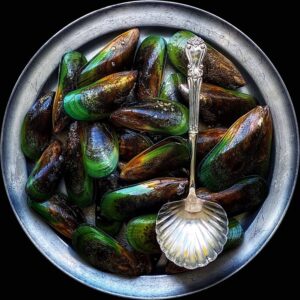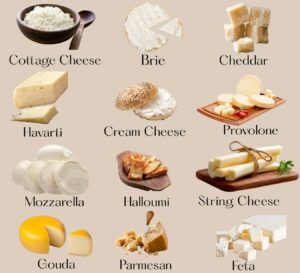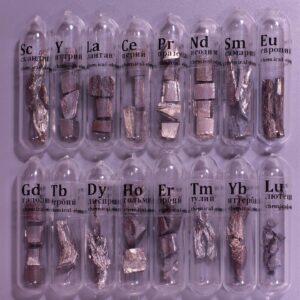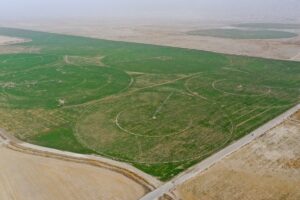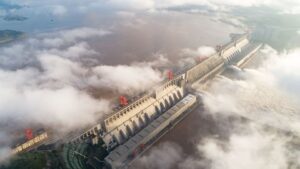Bamboo, a versatile and sustainable resource, has been utilized for thousands of years. Bamboo is one of the fastest-growing plants in the world, with some species capable of growing up to three feet in a single day. This rapid growth makes it an incredibly sustainable resource. Bamboo belongs to the grass family, and its production involves several key processes, from cultivation to processing.
 Pin
Pin Image by Kanenori from Pixabay
Table of Contents
How is Bamboo Produced?
1. Cultivation of Bamboo
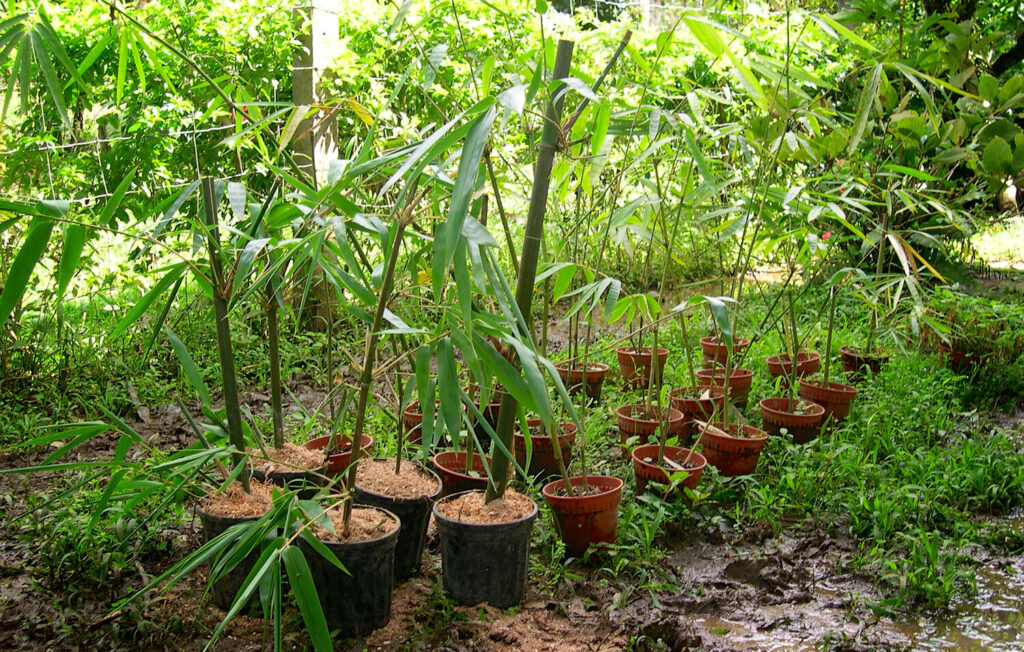 Pin
Pin Image from guaduabamboo
Selection of Species
Bamboo is a diverse group of plants with over 1,400 species, but not all are suitable for commercial use. The selection of species is crucial for successful cultivation and production.
- Commercially Viable Species: Only a few species are cultivated on a large scale due to their desirable characteristics. Moso bamboo (Phyllostachys edulis) is one of the most popular species for commercial purposes. It is favored for its large size, strength, and fast growth rate.
- Characteristics: Moso bamboo can grow up to 28 meters (92 feet) tall and has a diameter of up to 18 centimeters (7 inches). Its robust structure makes it ideal for construction, furniture, and various industrial applications.
- Other Species: While Moso bamboo is prominent, other species like Guadua angustifolia and Bambusa balcooa are also cultivated for specific uses, such as construction and paper production.
Planting
The planting process of bamboo involves several methods, each with its own advantages. Here’s a detailed look at how bamboo is planted:
- Propagation Methods: Bamboo can be propagated through seeds, cuttings, or rhizomes. Each method has its own benefits
- Seeds: Propagating bamboo from seeds is less common due to the infrequent flowering of bamboo plants. However, when seeds are available, they can be sown directly into the soil.
- Cuttings: This method involves taking a section of the bamboo culm (stem) and planting it in the soil. Cuttings should include at least one node (the part of the stem where leaves and roots grow) to ensure successful rooting.
- Rhizomes: The most common method is using rhizomes, which are the underground stems of the bamboo plant. Rhizomes are cut from a mature plant and planted horizontally in the soil. This method ensures rapid growth and establishment.
- Soil Requirements: Bamboo thrives in well-drained soil with a pH range of 6.0 to 6.5. It prefers loamy soil rich in organic matter. Proper soil preparation, including the addition of compost or manure, can enhance growth.
- Watering and Fertilization: Bamboo requires regular watering, especially during the initial stages of growth. However, it is relatively drought-tolerant once established. Minimal use of fertilizers and pesticides is needed, making bamboo cultivation environmentally friendly.
- Spacing and Planting Depth: Bamboo plants should be spaced adequately to allow for their extensive root systems. Planting depth varies depending on the propagation method, but generally, rhizomes are planted about 5-10 centimeters (2-4 inches) deep.
2. Growth of Bamboo
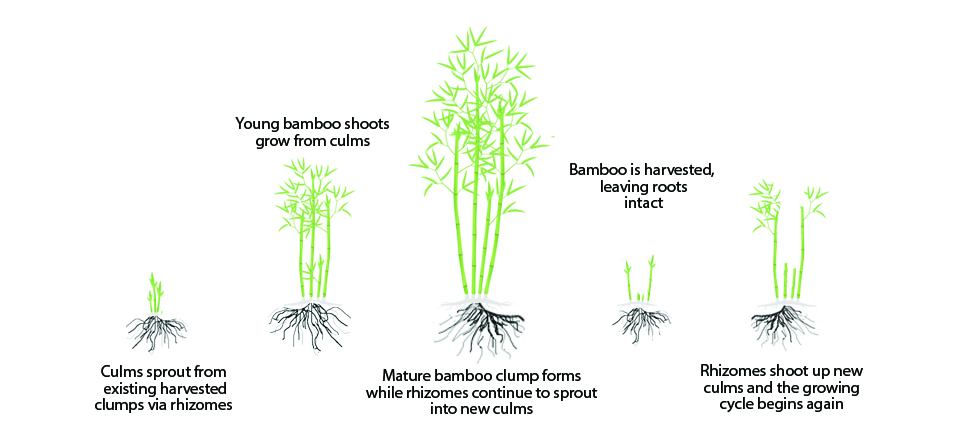 Pin
Pin Image from copernicused
Rapid Growth
Bamboo holds the title of one of the fastest-growing plants on the planet. Imagine this: some species of bamboo can grow up to 91 centimeters (35 inches) in just one day! That’s almost like watching a plant grow before your eyes.
- Speedy Growth: This rapid growth is due to the unique structure of bamboo. Unlike trees, which grow outward and upward slowly, bamboo grows in segments called “internodes.” These segments elongate quickly, allowing the plant to shoot up at an incredible pace.
- Maturity: While hardwood trees can take decades to reach maturity, bamboo is ready for harvest in just 3-5 years. This quick turnaround makes it an excellent renewable resource. By the time a hardwood tree is just getting started, bamboo has already gone through several growth cycles.
Sustainability
Bamboo’s sustainability is another reason it’s gaining popularity as an eco-friendly material. Here’s why:
- Regenerative Growth: One of the most remarkable features of bamboo is its ability to regenerate from its root system. After harvesting, bamboo doesn’t need to be replanted. Instead, it continues to grow from the existing root structure, known as rhizomes. This means less soil disturbance and a continuous supply of bamboo without the need for replanting.
- Environmental Benefits: Bamboo’s rapid growth and regenerative properties make it a highly sustainable resource. It helps prevent soil erosion, improves soil health, and absorbs more carbon dioxide compared to many other plants. Plus, it releases 35% more oxygen into the atmosphere than an equivalent stand of trees.
Bamboo’s rapid growth and sustainability make it a standout plant in the world of renewable resources. Its ability to grow quickly and regenerate without replanting ensures a steady supply of material while minimizing environmental impact. Whether it’s for construction, textiles, or everyday products, bamboo’s growth characteristics make it a green choice for a sustainable future.
3. Harvesting Bamboo
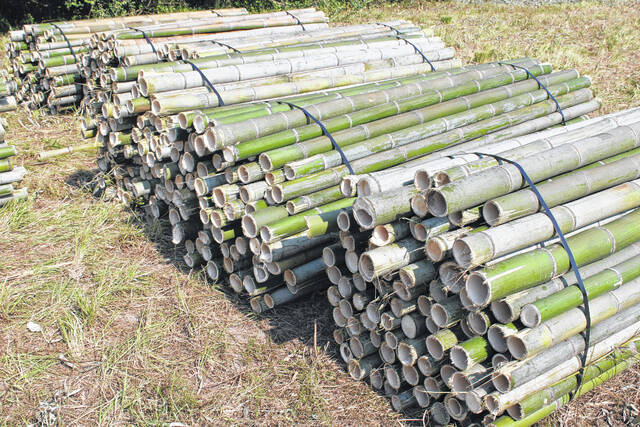 Pin
Pin Image from clintonnc
Selective Cutting
Selective cutting is a sustainable harvesting method that focuses on maintaining the health and productivity of the bamboo plant.
- Mature Culms: Only mature bamboo culms (stems) are harvested. These are typically 3-5 years old, as younger culms are still developing and older ones may become too hard and brittle. Harvesting mature culms ensures that the plant’s growth cycle is not disrupted.
- Health of the Plant: By selectively cutting mature culms, the bamboo plant can continue to grow and produce new shoots. This method prevents over-harvesting and ensures a continuous supply of bamboo. It also helps in maintaining the ecological balance of the bamboo forest.
- Sustainable Practice: Selective cutting is an eco-friendly practice that minimizes soil disturbance and promotes the regeneration of bamboo. It allows for a sustainable and renewable source of bamboo without the need for replanting.
Processing
Once harvested, bamboo undergoes various processing steps to transform it into usable materials. The processing methods depend on the intended use of the bamboo.
- Strips: Bamboo culms are split into strips, which can be used for making flooring, panels, and other construction materials. The strips are treated to remove moisture and prevent pests, ensuring durability and longevity.
- Fibers: Bamboo fibers are extracted from the culms and processed into yarns and fabrics. This involves breaking down the bamboo into a pulp, which is then spun into fibers. Bamboo fabric is known for its softness, breathability, and antibacterial properties.
- Pulp: Bamboo pulp is used to make paper and packaging materials. The culms are chipped into small pieces and cooked to break down the fibers. The resulting pulp is then processed into paper products, providing a sustainable alternative to wood pulp.
- Other Forms: Depending on the intended use, bamboo can also be processed into various other forms, such as veneers, laminates, and composites. These materials are used in furniture, utensils, and even innovative products like bicycles and musical instruments.
The harvesting and processing of bamboo are carefully managed to ensure sustainability and versatility. Selective cutting maintains the health of the bamboo plant, while various processing methods transform the harvested bamboo into a wide range of products. This sustainable approach makes bamboo an invaluable resource for eco-friendly and innovative applications.
What Products Can Be Made from Bamboo?
1. Construction Materials Made from Bamboo
Flooring and Panels
Bamboo is a popular material for flooring and wall panels due to its durability and natural beauty.
- Durable Flooring: Bamboo flooring is known for its hardness and resilience. It is comparable to hardwood in terms of strength but has the added benefit of being more sustainable. Bamboo flooring comes in various styles, including horizontal, vertical, and strand-woven. Strand-woven bamboo flooring is particularly durable, as it is made by compressing bamboo fibers under high pressure, resulting in a dense and hard surface.
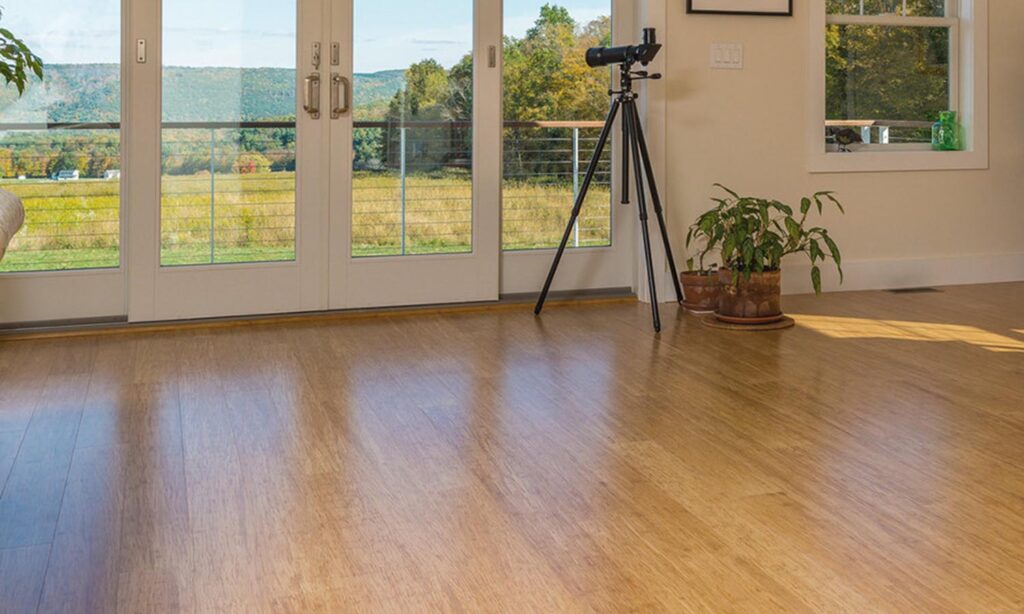 Pin
Pin Image from modernbamboo
- Aesthetic Appeal: Bamboo flooring and panels offer a unique and attractive look. The natural grain and color variations of bamboo add warmth and character to any space. Additionally, bamboo can be stained or carbonized to achieve different shades and finishes, making it a versatile option for various interior design styles.
- Eco-Friendly Choice: Bamboo is a rapidly renewable resource, reaching maturity in just 3-5 years. This makes it a more sustainable option compared to traditional hardwoods, which can take decades to mature. Using bamboo for flooring and panels helps reduce deforestation and promotes environmentally friendly construction practices.
Scaffolding
In many Asian countries, bamboo scaffolding is a common sight on construction sites. Its flexibility and strength make it an ideal material for this purpose.
- Flexibility and Strength: Bamboo scaffolding is highly flexible, allowing it to bend without breaking. This flexibility is crucial for scaffolding, as it needs to adapt to various shapes and structures. Despite its flexibility, bamboo is incredibly strong and can support significant weight, making it a reliable material for scaffolding.
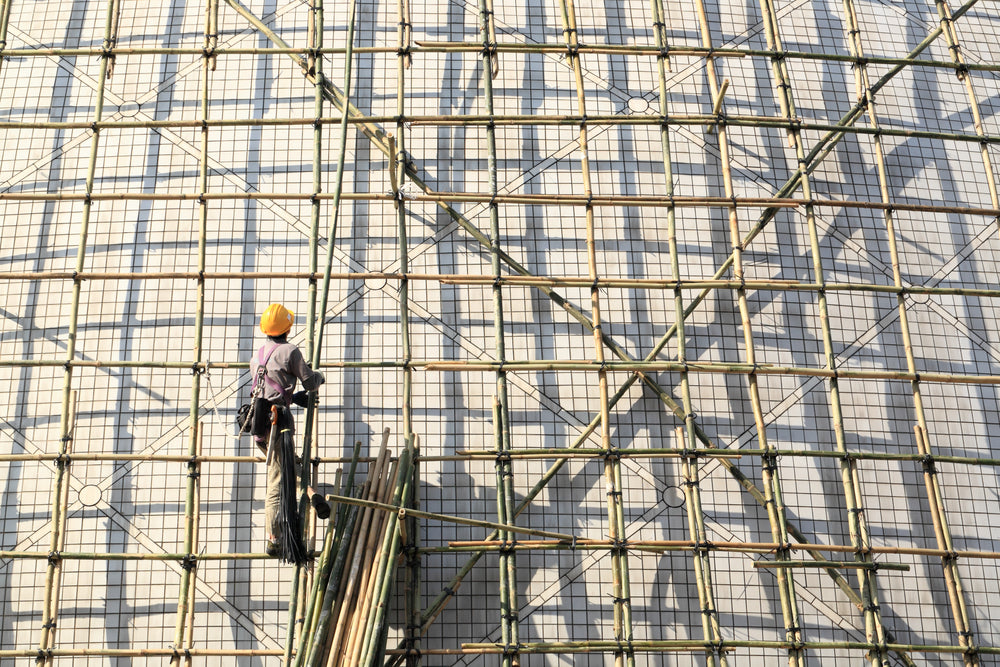 Pin
Pin Image from northbynorth
- Ease of Use: Bamboo scaffolding is relatively easy to assemble and dismantle. The lightweight nature of bamboo makes it easy to transport and handle on construction sites. Workers can quickly erect and adjust bamboo scaffolding, which is essential for efficient construction processes.
- Cost-Effective: Bamboo is often more affordable than metal scaffolding materials. Its abundance and rapid growth make it a cost-effective option for construction projects, especially in regions where bamboo is readily available.
- Cultural Significance: In addition to its practical benefits, bamboo scaffolding holds cultural significance in many Asian countries. It has been used for centuries in traditional construction methods and continues to be a symbol of craftsmanship and heritage.
Bamboo’s use in construction materials like flooring, panels, and scaffolding highlights its versatility and sustainability. Its strength, aesthetic appeal, and eco-friendly properties make it an excellent choice for modern construction projects. Whether you’re looking to create a beautiful interior space or build a sturdy scaffold, bamboo offers a reliable and sustainable solution.
2. Textiles Made from Bamboo: Soft, Sustainable, and Versatile
Fabrics
Bamboo fabrics are gaining popularity due to their unique properties and eco-friendly nature. Here’s a detailed look at how bamboo fibers are processed into fabrics and their benefits:
- Processing Bamboo Fibers: The process of turning bamboo into fabric involves several steps. First, the bamboo stalks are harvested and cut into small pieces. These pieces are then soaked in a solution to break down the bamboo into a pulp. The pulp is then mechanically or chemically processed to extract the cellulose fibers. These fibers are spun into yarns, which are woven or knitted into fabrics.
 Pin
Pin Image from yushengmax
- Soft and Breathable: Bamboo fabric is incredibly soft, often compared to the feel of silk or cashmere. Its smooth texture makes it comfortable to wear and gentle on the skin. Additionally, bamboo fabric is highly breathable, allowing air to circulate and keeping the wearer cool and comfortable.
- Moisture-Wicking: One of the standout properties of bamboo fabric is its moisture-wicking ability. It can absorb moisture away from the skin, keeping the wearer dry and comfortable. This makes bamboo fabric an excellent choice for activewear, underwear, and bed linens.
- Antibacterial Properties: Bamboo fabric naturally possesses antibacterial properties, which help reduce the growth of bacteria and odors. This makes it ideal for clothing, towels, and other items that come into close contact with the skin.
- Eco-Friendly: Bamboo is a sustainable resource that grows rapidly and requires minimal pesticides and fertilizers. The production of bamboo fabric has a lower environmental impact compared to conventional cotton and synthetic fibers.
Yarns
Bamboo yarns are another versatile product derived from bamboo fibers. They offer a sustainable alternative to synthetic fibers and are used in various knitting and weaving applications.
- Knitting and Weaving: Bamboo yarns are used in knitting and weaving to create a wide range of products, including clothing, accessories, and home textiles. The yarns are known for their softness, strength, and durability, making them suitable for both hand and machine knitting.
 Pin
Pin Image from woolcraft.co.za
- Sustainable Alternative: Bamboo yarns provide a sustainable alternative to synthetic fibers like polyester and nylon. They are biodegradable and have a lower environmental impact, contributing to more eco-friendly textile production.
- Versatility: Bamboo yarns can be blended with other fibers, such as cotton, wool, or silk, to enhance their properties and create unique textures. This versatility allows for a wide range of applications, from lightweight summer garments to cozy winter wear.
Bamboo’s use in textiles highlights its versatility and sustainability. Bamboo fabrics offer softness, breathability, moisture-wicking, and antibacterial properties, making them ideal for clothing, bed linens, and towels. Bamboo yarns provide a sustainable and versatile option for knitting and weaving, contributing to eco-friendly textile production. Whether you’re looking for comfortable clothing or sustainable yarns, bamboo is a fantastic choice.
3. Household Items Made from Bamboo: Stylish, Durable, and Eco-Friendly
Furniture
Bamboo furniture is not only stylish but also incredibly durable. Here’s a detailed look at how bamboo is crafted into various pieces of furniture:
- Stylish Designs: Bamboo furniture is known for its elegant and modern designs. The natural grain and color of bamboo add a unique aesthetic appeal to any piece. Whether it’s a minimalist chair or a sophisticated table, bamboo furniture can complement various interior design styles.
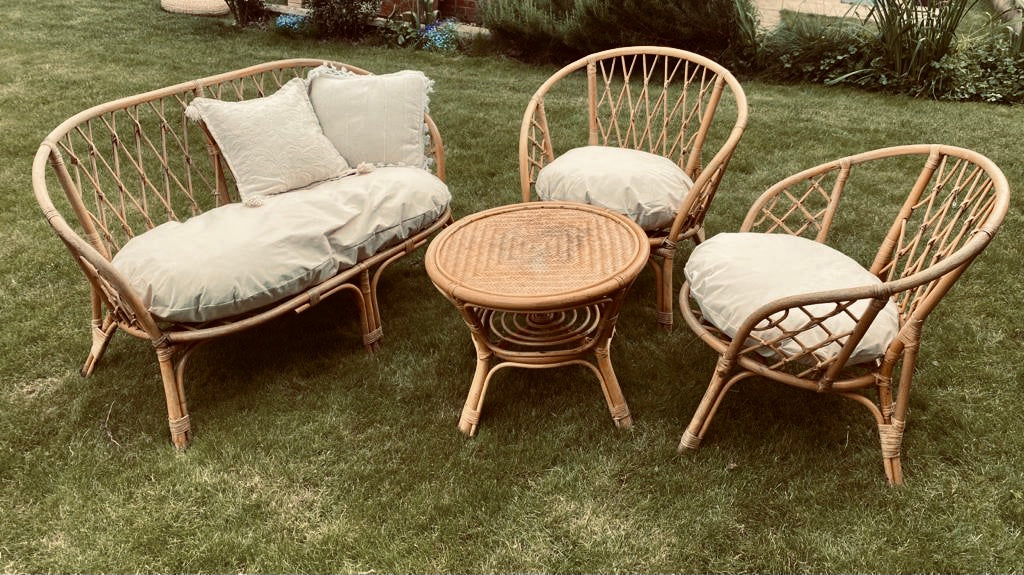 Pin
Pin Image from rocktheday
- Durability: Bamboo is a strong and resilient material, making it ideal for furniture. It can withstand heavy use and is resistant to wear and tear. This durability ensures that bamboo furniture can last for many years, providing excellent value for money.
- Variety of Pieces: Bamboo is used to craft a wide range of furniture items, including chairs, tables, cabinets, beds, and shelves. Each piece is carefully designed and constructed to ensure stability and comfort. Bamboo’s flexibility also allows for creative and intricate designs that are both functional and visually appealing.
- Eco-Friendly Choice: Choosing bamboo furniture is an environmentally friendly decision. Bamboo grows rapidly and regenerates without the need for replanting, making it a sustainable resource. Bamboo furniture production typically involves fewer chemicals and less energy compared to traditional wood furniture.
Utensils and Kitchenware
Bamboo is also a popular material for kitchen utensils and kitchenware, offering both functionality and sustainability. Here’s how bamboo is used in the kitchen:
- Kitchen Utensils: Bamboo is used to make a variety of kitchen utensils, including spoons, spatulas, tongs, and ladles. These utensils are lightweight, durable, and gentle on cookware, making them ideal for everyday use. Bamboo utensils are also heat-resistant and do not conduct heat, ensuring safe and comfortable handling.
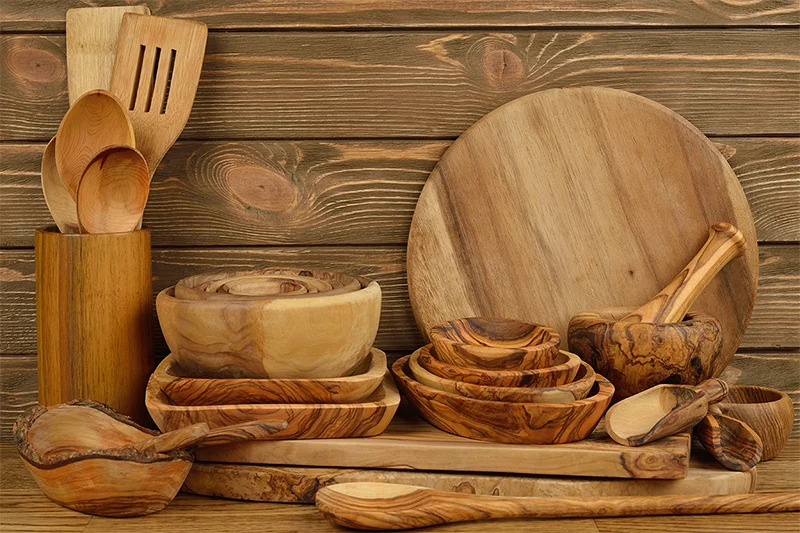 Pin
Pin Image from yibamboo
- Cutting Boards: Bamboo cutting boards are a popular choice due to their durability and knife-friendly surface. They are less prone to cracking and warping compared to traditional wooden cutting boards. Bamboo’s natural antibacterial properties also make it a hygienic option for food preparation.
- Disposable Plates and Cutlery: Bamboo is used to produce eco-friendly disposable plates, bowls, and cutlery. These items are biodegradable and compostable, providing a sustainable alternative to plastic disposables. Bamboo disposable kitchenware is perfect for picnics, parties, and other events where convenience and environmental responsibility are important.
- Other Kitchenware: Bamboo is also crafted into various other kitchen items, such as serving trays, bowls, and storage containers. These items combine functionality with a natural and rustic charm, enhancing the overall aesthetic of the kitchen.
Bamboo’s use in household items highlights its versatility and sustainability. Bamboo furniture offers stylish and durable options for home decor, while bamboo kitchenware provides functional and eco-friendly solutions for everyday use. By incorporating bamboo into your household, you can enjoy the benefits of a renewable resource that is both beautiful and practical.
4. Paper and Packaging Made from Bamboo: Sustainable and Eco-Friendly Solutions
Paper Products
Bamboo pulp is increasingly being used to produce a variety of paper products, offering a sustainable alternative to wood pulp.
- Production Process: The process of making paper from bamboo involves several steps. First, the bamboo culms are harvested and chipped into small pieces. These chips are then cooked in a solution to break down the fibers and create a pulp. The pulp is washed, refined, and formed into sheets of paper through pressing and drying.
 Pin
Pin Image from stay-well.eu
- Types of Paper Products: Bamboo pulp is used to produce a wide range of paper products, including:
- Writing and Printing Paper: Bamboo paper is suitable for writing and printing, offering a smooth surface and good ink absorption. It is used for notebooks, office paper, and other stationery items.
- Tissues and Towels: Bamboo fibers are soft and absorbent, making them ideal for tissues, paper towels, and napkins. These products are gentle on the skin and provide excellent performance.
- Toilet Paper: Bamboo toilet paper is becoming popular due to its softness and strength. It is also biodegradable and septic-safe, making it an environmentally friendly choice.
- Packaging Materials: Bamboo pulp is used to create various packaging materials, such as cardboard, cartons, and wrapping paper. These materials are sturdy and provide excellent protection for goods during transportation.
Packaging
Bamboo-based packaging is gaining traction as a sustainable alternative to plastic and other non-biodegradable materials.
- Biodegradable and Compostable: One of the key advantages of bamboo packaging is its biodegradability. Bamboo packaging materials break down naturally over time, reducing the environmental impact compared to plastic packaging. They can also be composted, returning nutrients to the soil and supporting a circular economy.
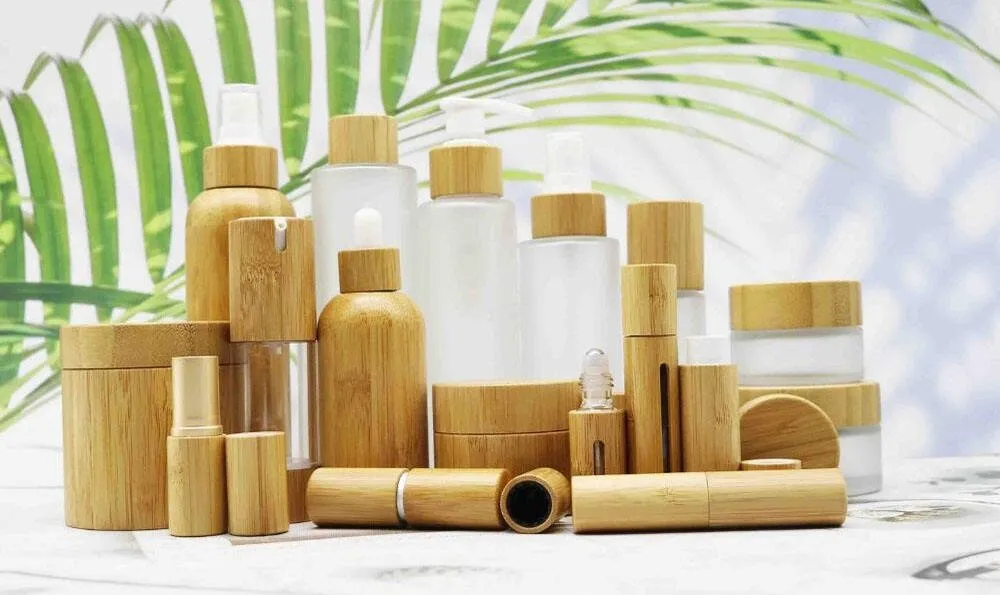 Pin
Pin Image from threebamboo
- Types of Bamboo Packaging: Bamboo is used to create a variety of packaging solutions, including:
- Food Packaging: Bamboo-based packaging is safe for food contact and is used for containers, trays, and wraps. It helps keep food fresh while minimizing environmental impact.
- Retail Packaging: Bamboo packaging is used for retail products, such as cosmetics, electronics, and clothing. It provides a premium look and feel, enhancing the overall presentation of the product.
- Shipping Materials: Bamboo is used to produce shipping materials, such as boxes, cushioning, and protective wraps. These materials are strong and durable, ensuring that products are safely transported.
- Environmental Benefits: Using bamboo for packaging helps reduce reliance on plastic and other non-renewable resources. Bamboo’s rapid growth and minimal need for pesticides and fertilizers make it a highly sustainable option. Additionally, bamboo packaging production typically involves fewer chemicals and less energy compared to traditional packaging materials.
5. Innovative Uses of Bamboo: Bicycles and Musical Instruments
Bicycles
Bamboo-based packaging is gaining traction as a sustainable alternative to plastic and other non-biodegradable materials.
- Strength and Durability: Bamboo is incredibly strong and can withstand significant stress and impact. This makes it a reliable material for bicycle frames, which need to be both sturdy and resilient. Bamboo’s natural fibers provide excellent tensile strength, comparable to that of steel.
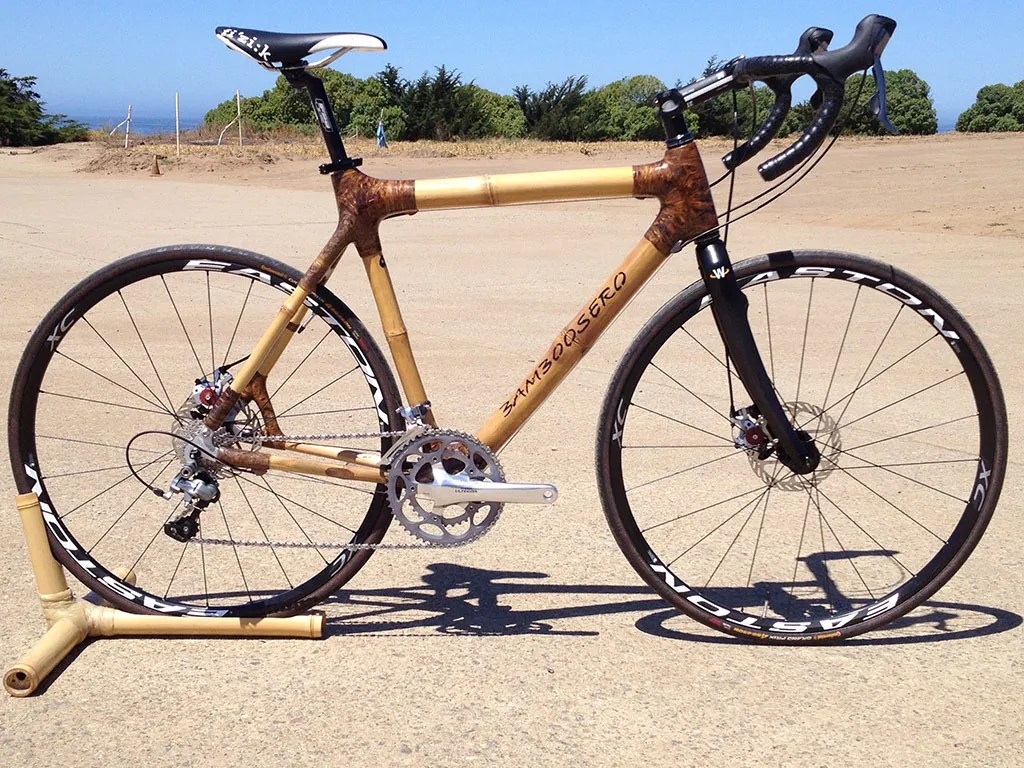 Pin
Pin Image from bikenoob
- Flexibility: Bamboo’s flexibility allows it to absorb shocks and vibrations, providing a smoother ride. This is particularly beneficial for cyclists who ride on rough or uneven terrain. The natural damping properties of bamboo help reduce fatigue and improve comfort.
- Lightweight: Despite its strength, bamboo is relatively lightweight. This makes bamboo bicycles easier to handle and maneuver, enhancing the overall riding experience. The combination of strength and lightness is a key advantage for both casual riders and competitive cyclists.
- Sustainability: Bamboo is a renewable resource that grows rapidly and requires minimal pesticides and fertilizers. Using bamboo for bicycle frames reduces the environmental impact compared to traditional materials like aluminum or carbon fiber. Bamboo bicycles are an eco-friendly choice for environmentally conscious consumers.
- Aesthetic Appeal: Bamboo bicycles have a unique and attractive appearance. The natural grain and color of bamboo add a distinctive look to the frames, making each bicycle a work of art. This aesthetic appeal, combined with the performance benefits, makes bamboo bicycles a popular choice among cyclists.
Musical Instruments
Bamboo’s acoustic properties make it an excellent material for crafting both traditional and modern musical instruments. Here’s how bamboo is used in the world of music:
- Traditional Instruments: Bamboo has been used for centuries to create traditional musical instruments in various cultures. Some examples include:
- Flutes: Bamboo flutes are known for their clear and melodious sound. The natural hollow structure of bamboo makes it an ideal material for wind instruments. Bamboo flutes are used in many traditional music forms around the world.
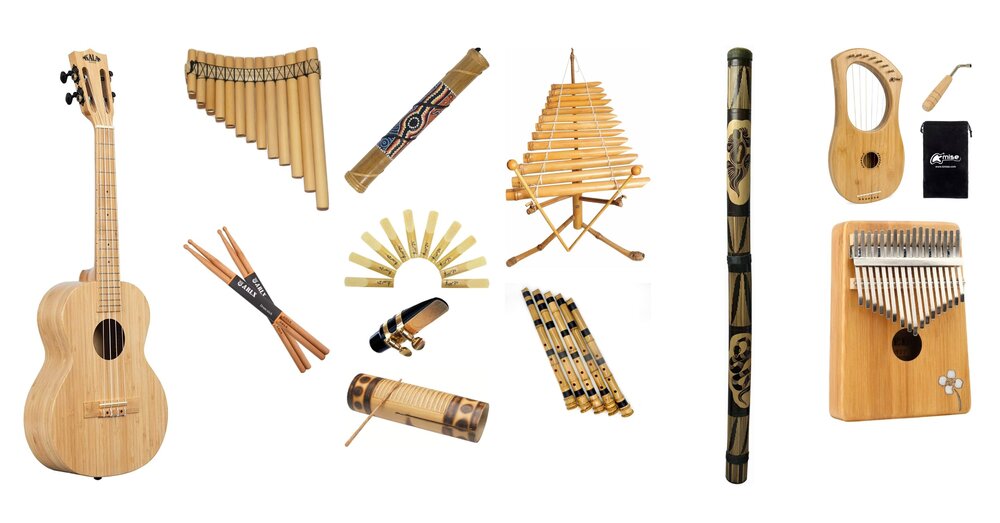 Pin
Pin Image from guaduabamboo
- Percussion Instruments: Bamboo is used to make various percussion instruments, such as xylophones, marimbas, and slit drums. The resonant qualities of bamboo produce rich and vibrant tones, making these instruments popular in traditional music.
- Modern Instruments: In addition to traditional instruments, bamboo is also used in modern musical instrument construction. Some examples include: 1. Guitars: Bamboo is used to make guitar bodies and necks. Its strength and flexibility provide excellent resonance and sustain, contributing to the overall sound quality of the instrument. Bamboo guitars are appreciated for their unique tonal characteristics and eco-friendly nature. 2. Wind Instruments: Modern wind instruments, such as clarinets and saxophones, sometimes incorporate bamboo components. The natural properties of bamboo enhance the acoustic performance of these instruments, providing a warm and rich sound.
- Sustainability: Using bamboo for musical instruments supports sustainable practices in the music industry. Bamboo’s rapid growth and minimal environmental impact make it a responsible choice for instrument makers and musicians who prioritize sustainability.
Bamboo’s rapid growth, sustainability, and versatility make it an invaluable resource for a wide range of products. From construction materials to textiles and innovative applications, bamboo continues to play a crucial role in promoting eco-friendly practices and reducing our environmental footprint.
By understanding how bamboo is produced and the myriad products it can create, we can appreciate its potential to contribute to a more sustainable future.
FAQs on Bamboo Production and Products
There are over 1,400 species of bamboo, but only a few are suitable for commercial use. Moso bamboo (Phyllostachys edulis) is one of the most popular species due to its large size and strength.
Bamboo can be propagated through seeds, cuttings, or rhizomes. It thrives in well-drained soil and requires minimal fertilizers and pesticides.
Bamboo is one of the fastest-growing plants in the world, with some species growing up to 91 cm (35 inches) per day. It reaches maturity in 3-5 years, unlike hardwood trees that can take decades.
Yes, bamboo regenerates from its root system, meaning it doesn’t need to be replanted after harvesting. This makes it a highly sustainable resource.
Bamboo is used to make durable flooring, wall panels, and veneers. Its strength and aesthetic appeal make it a popular choice for eco-friendly construction. Additionally, bamboo scaffolding is preferred in many Asian countries for its flexibility and strength.
Bamboo fibers are processed into soft, breathable fabrics used in clothing, bed linens, and towels. Bamboo fabric is known for its moisture-wicking and antibacterial properties. Bamboo yarns are also used in knitting and weaving, offering a sustainable alternative to synthetic fibers.
Bamboo is crafted into stylish and durable furniture, including chairs, tables, and cabinets. It is also used to make a variety of kitchen utensils, cutting boards, and even disposable plates and cutlery.
Bamboo pulp is used to produce paper, tissues, and packaging materials, providing a sustainable alternative to wood pulp. Bamboo-based packaging is biodegradable and eco-friendly, reducing the environmental impact of plastic.
Bamboo’s strength and flexibility make it an excellent material for bicycle frames. Additionally, bamboo’s acoustic properties make it ideal for crafting traditional and modern musical instruments, such as flutes and guitars.














